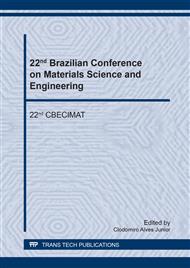p.207
p.212
p.218
p.224
p.230
p.236
p.241
p.248
p.254
Addition of Zinc Oxide Nanoparticles in Biodegradable Polymer and Evaluation of its Antimicrobial Activity
Abstract:
The food contamination for pathogenic microorganisms is a serious problem for the food security. Many actions can be taken in order to reduce this pathogenic multiplication, highlighting the use of active packaging for the food conservation, which have antimicrobial agents dispersed in its surface. The metal oxides and its nanoparticles have been shown effective additives for this purpose. With the growing concern with the environmental and the use of less aggressive materials, biodegradable polymers emerge like a good alternative. This work has the goal to investigate the effect on antimicrobial activity against Gram negative (Escherichia coli) and Gram positive (Staphylococcus aureus) bacteria when added zinc oxide nanoparticles (ZnO NPs) in concentration of 1% (wt/wt) in the biodegrable polymer Ecoflex®. The system was homogenized and proccessed in industrial extruder single screw and the polymer’s antimicrobial activity was evaluated by the agar diffusion tests and counting surviving microorganisms with the time. The results showed that the biodegradable polymer Ecoflex® with ZnO NPs exhibit good antibacterial activity.
Info:
Periodical:
Pages:
230-235
Citation:
Online since:
September 2018
Price:
Сopyright:
© 2018 Trans Tech Publications Ltd. All Rights Reserved
Share:
Citation:


